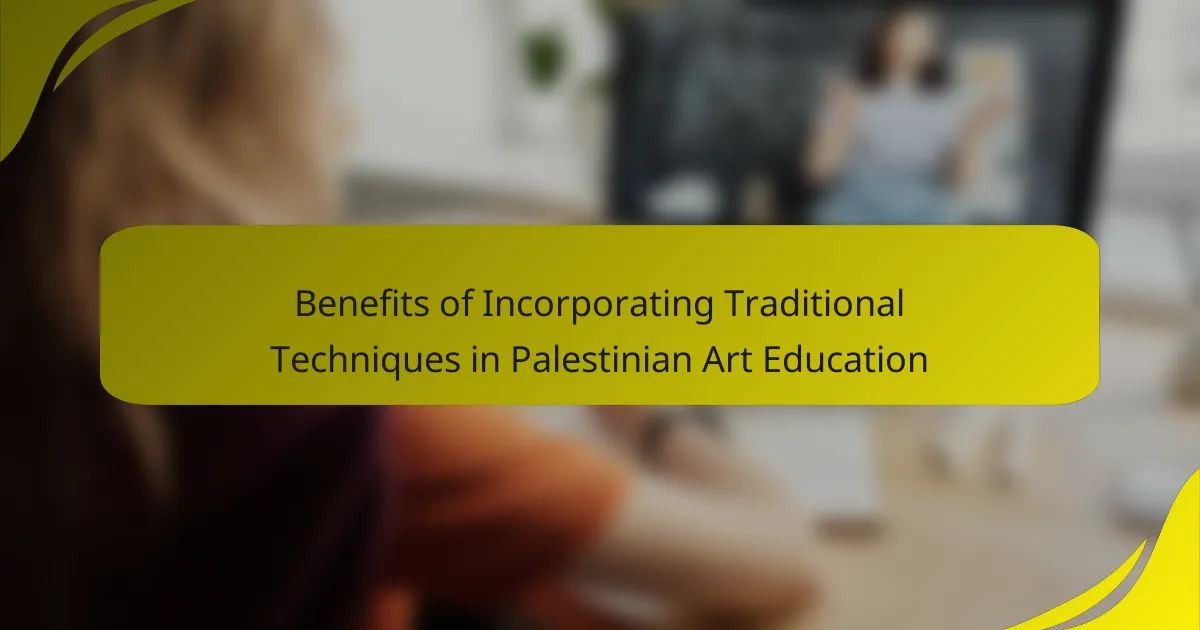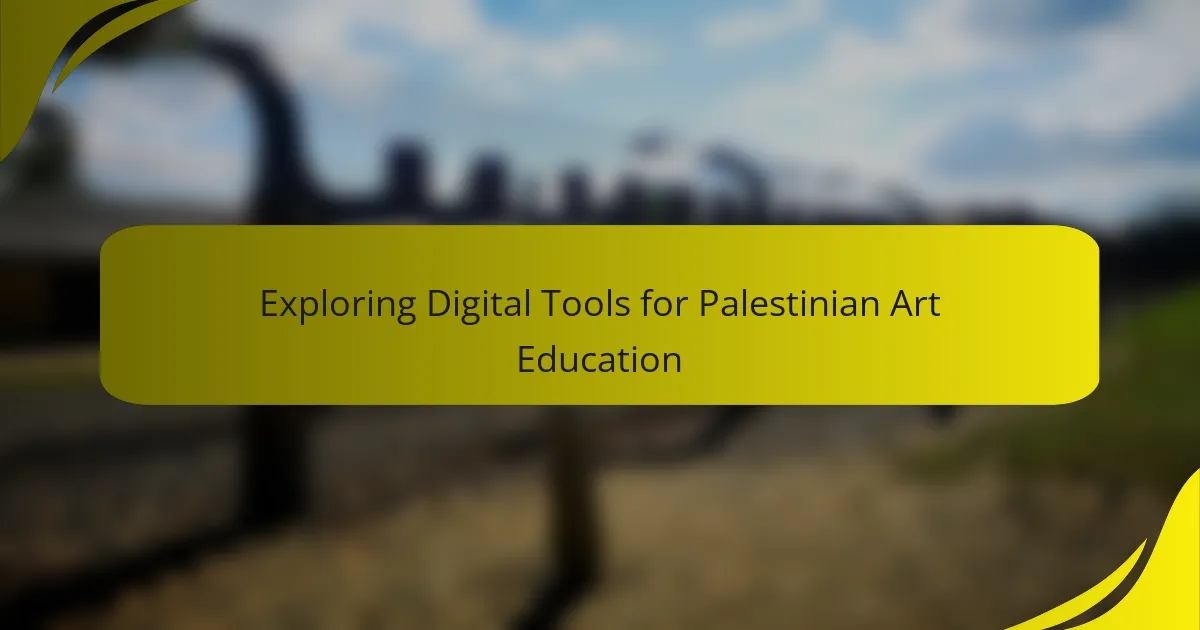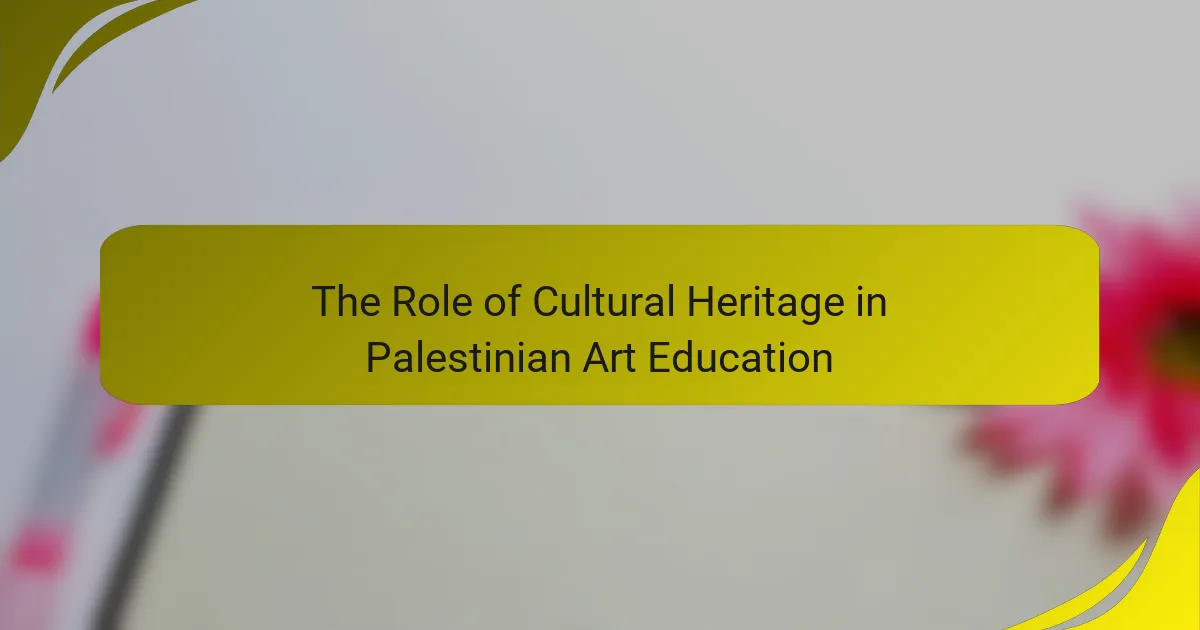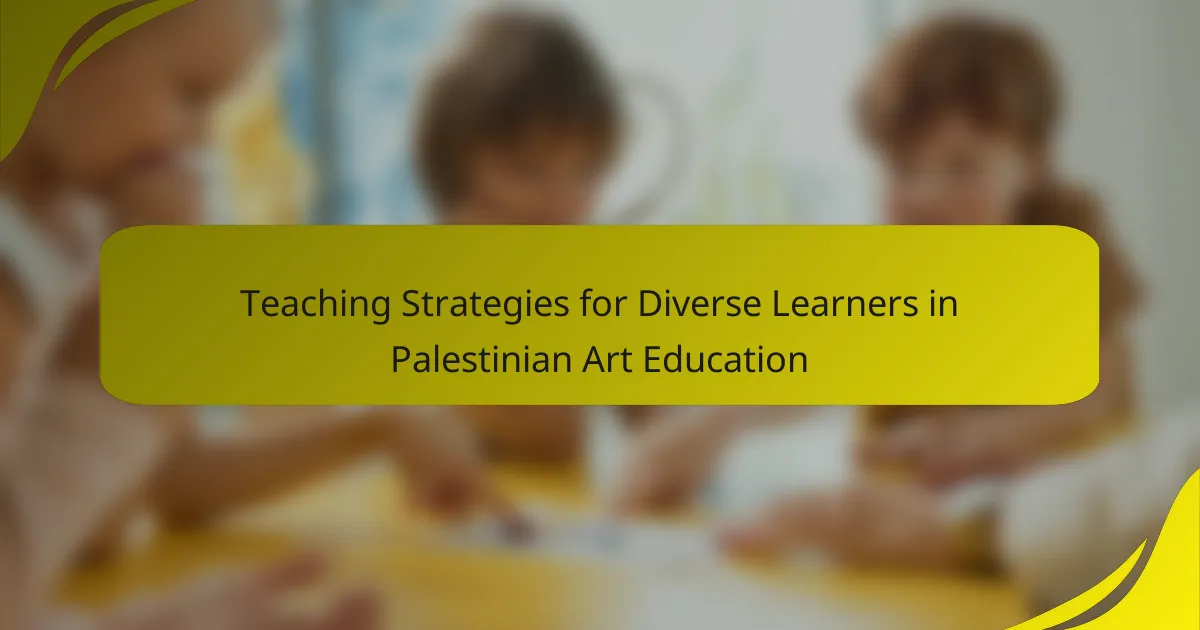Integrating contemporary issues into Palestinian art education involves incorporating current social, political, and cultural themes into the curriculum to enhance students’ understanding of their identity and societal challenges. This educational approach promotes critical thinking and dialogue on pressing matters such as occupation, displacement, and cultural heritage. However, challenges such as limited resources, political constraints, and the need for professional development for educators can hinder effective implementation. Strategies for successful integration include designing relevant curricula, engaging in community-based projects, collaborating with local artists, utilizing digital platforms, and fostering critical discussions in the classroom. These efforts aim to empower students and support the development of a unique Palestinian artistic voice while facilitating art as a tool for activism and social change.
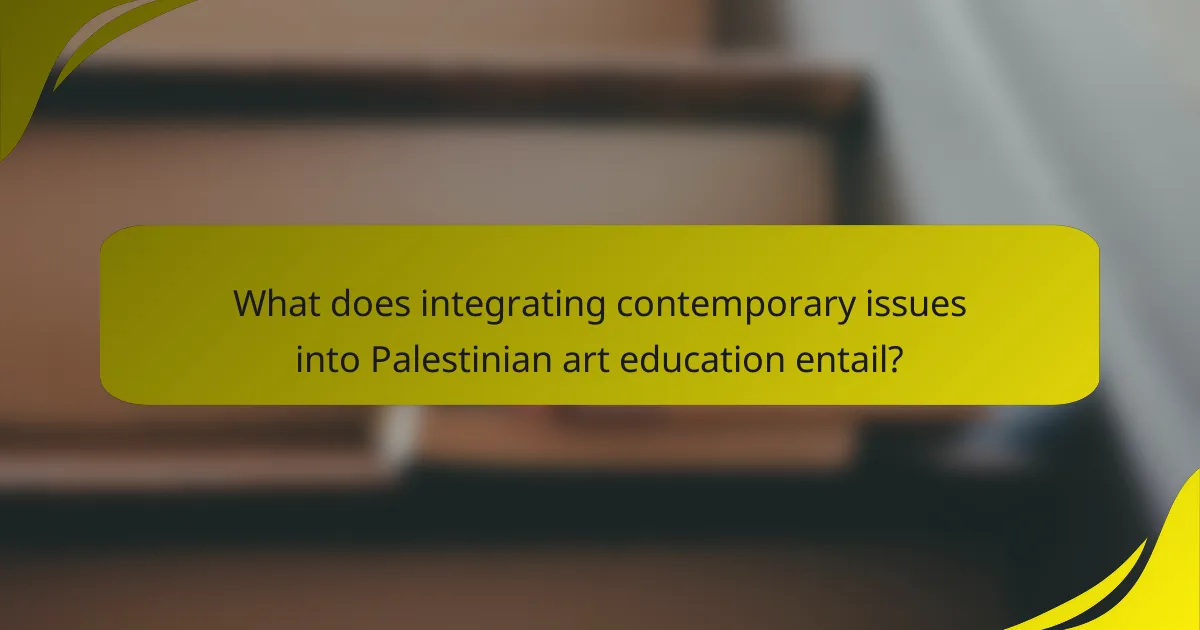
What does integrating contemporary issues into Palestinian art education entail?
Integrating contemporary issues into Palestinian art education entails incorporating current social, political, and cultural themes into the curriculum. This approach encourages students to explore their identity and societal challenges through artistic expression. It fosters critical thinking and dialogue about pressing issues such as occupation, displacement, and cultural heritage. Educators aim to connect students with global art movements and local narratives. This integration supports the development of a unique Palestinian artistic voice. It also empowers students to engage with their community through art. By addressing contemporary issues, art education becomes a tool for activism and social change. This method has been shown to enhance students’ engagement and creativity in their work.
How do contemporary issues influence Palestinian art education?
Contemporary issues significantly influence Palestinian art education by shaping its themes and methodologies. The ongoing political conflict impacts artistic expression, often focusing on resistance and identity. This context encourages students to explore their cultural heritage through art. Moreover, contemporary social issues, such as displacement and human rights, are frequently addressed in art curricula. Educational institutions aim to foster critical thinking about these challenges. Artists like Emily Jacir and Khalil Rabah exemplify this integration in their works. Their art reflects personal and collective experiences related to contemporary issues. Consequently, Palestinian art education becomes a tool for social commentary and empowerment.
What are the key contemporary issues impacting Palestinian society?
Key contemporary issues impacting Palestinian society include political conflict, economic instability, and social fragmentation. The ongoing Israeli-Palestinian conflict continues to affect daily life and governance. Restrictions on movement and access to resources exacerbate economic challenges. Unemployment rates among Palestinians are high, particularly among youth, reaching around 40%. Social fragmentation is evident in the divisions between different political factions, such as Fatah and Hamas. Additionally, cultural identity is challenged by external pressures and the occupation. Access to education and healthcare remains limited, further complicating societal development. These factors collectively hinder the potential for artistic expression and education within Palestinian communities.
How can these issues be reflected in art education curricula?
Contemporary issues can be reflected in art education curricula by incorporating themes relevant to students’ lives. This includes addressing social justice, identity, and cultural heritage. Art educators can design projects that encourage critical thinking about these issues. For example, students could create artwork that responds to local community challenges. This method fosters engagement and personal connection to the subject matter. Additionally, curricula can include discussions on historical and current events impacting Palestinian society. Integrating diverse perspectives in art history can enrich students’ understanding. This approach supports the development of empathy and awareness in young artists.
Why is it important to integrate contemporary issues in art education?
Integrating contemporary issues in art education is crucial for fostering critical thinking and social awareness. This approach enables students to engage with relevant societal challenges. It encourages them to reflect on their own experiences and cultural contexts. Art becomes a medium for dialogue and expression of current events. Students learn to analyze and interpret artworks in relation to contemporary themes. This integration enriches their understanding of the world around them. It also prepares them for active participation in society as informed citizens. Research shows that students exposed to contemporary issues develop greater empathy and creativity in their work.
What benefits does this integration provide to students?
This integration provides students with enhanced critical thinking skills. Students engage with contemporary issues, fostering deeper analysis and reflection. The curriculum encourages creativity by allowing students to express their perspectives through art. Students also develop a greater understanding of cultural and social contexts. This integration promotes empathy as students explore diverse viewpoints. It prepares students for real-world challenges by linking art to current events. Additionally, collaborative projects enhance teamwork and communication skills among students. Overall, this approach enriches the educational experience by making art relevant to students’ lives.
How does it enhance cultural awareness and sensitivity?
Integrating contemporary issues into Palestinian art education enhances cultural awareness and sensitivity by exposing students to diverse perspectives. This approach allows students to engage with various cultural narratives and histories. It fosters critical thinking about social issues within their own context and beyond. Students learn to appreciate cultural differences and similarities through artistic expression. This experience encourages empathy and understanding among peers from different backgrounds. Research shows that art education can bridge cultural divides and promote dialogue. For example, the work of artists like Emily Jacir highlights Palestinian experiences, fostering greater awareness in audiences. Thus, integrating contemporary issues in art education cultivates a more inclusive environment.
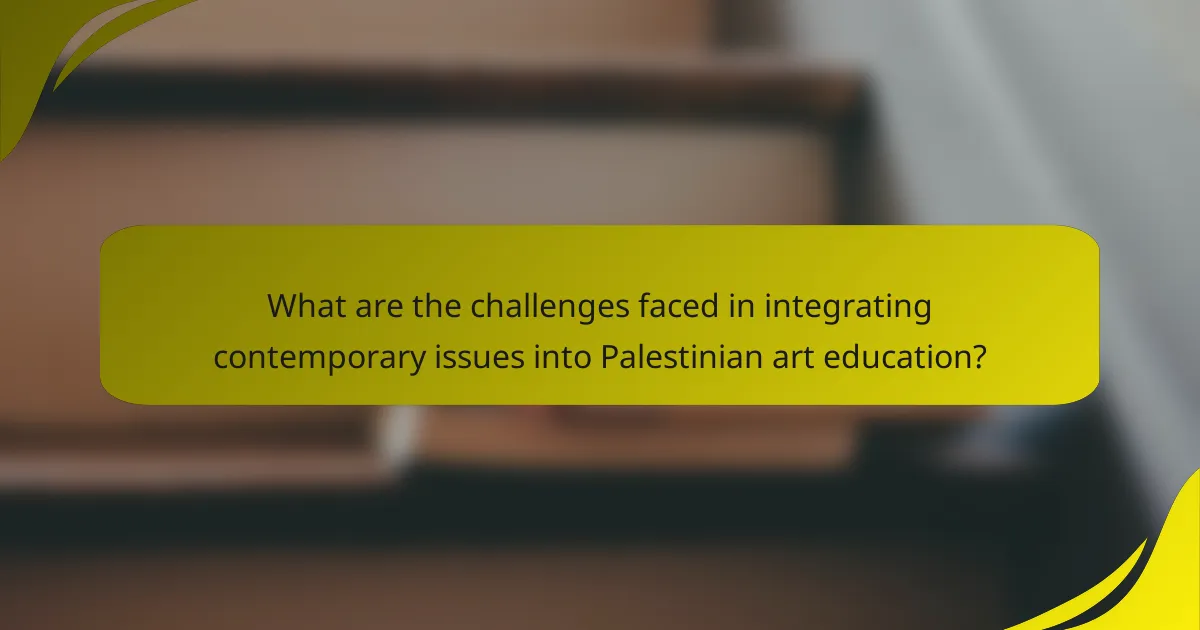
What are the challenges faced in integrating contemporary issues into Palestinian art education?
The challenges faced in integrating contemporary issues into Palestinian art education include limited resources and political constraints. Educational institutions often lack funding for materials and training. Additionally, the political situation restricts freedom of expression in art. This can hinder discussions on sensitive contemporary topics. Cultural identity and heritage also play a complex role in shaping the curriculum. Teachers may struggle to balance traditional art forms with modern issues. Furthermore, there is a need for professional development for educators in contemporary practices. These challenges collectively impact the effectiveness of art education in addressing relevant societal issues.
How do socio-political factors affect art education in Palestine?
Socio-political factors significantly affect art education in Palestine. The ongoing conflict and occupation create barriers to accessing resources and safe learning environments. Restrictions on movement limit students’ ability to attend classes and participate in workshops. Additionally, political instability influences curriculum content, often prioritizing national identity over artistic expression. Funding for art programs is frequently inadequate due to economic constraints imposed by the political situation. Cultural censorship can also stifle creativity and limit the exploration of diverse artistic themes. These factors collectively hinder the development of a robust art education system in Palestine.
What role do local policies play in shaping art education?
Local policies significantly influence the structure and delivery of art education. They determine funding levels for arts programs within schools. Policies can mandate curriculum standards that include art education as a core subject. Local governments often establish partnerships with community organizations to enhance art offerings. Regulations may also influence teacher training and professional development in the arts. For example, policies that prioritize creative industries can lead to increased support for art programs. In regions like Palestine, local policies can address cultural preservation through art education initiatives. This connection fosters a sense of identity and community engagement in the arts.
How do economic conditions influence access to art education?
Economic conditions significantly influence access to art education. Limited funding in economically disadvantaged areas restricts resources for art programs. Schools in low-income neighborhoods often lack qualified art teachers. This results in fewer art classes and opportunities for students. Economic downturns can lead to cuts in arts funding at local and state levels. Consequently, students may face barriers to participating in art education. Research shows that students in affluent areas have more access to diverse art programs. For instance, a study by the National Endowment for the Arts found that students in high-income communities are more likely to receive quality art instruction. Thus, economic conditions directly impact the availability and quality of art education.
What resistance or barriers exist within educational institutions?
Resistance and barriers within educational institutions often stem from rigid curricula and traditional teaching methods. These institutions may prioritize standardized testing over creative expression. Limited funding can restrict access to contemporary resources and materials. Cultural norms may discourage innovative approaches to art education. Additionally, administrative resistance to change can inhibit the integration of contemporary issues. Faculty may lack training in modern pedagogical strategies. Resistance from parents and the community can also impact curriculum decisions. These factors collectively hinder the evolution of art education in Palestinian contexts.
How do traditional views on art impact contemporary integration?
Traditional views on art significantly influence contemporary integration. These views often prioritize historical techniques and cultural narratives. They shape the way contemporary artists approach their work. For instance, adherence to traditional forms can limit experimentation. This is particularly evident in Palestinian art, where cultural identity plays a crucial role. Artists may feel pressure to conform to established norms. However, blending traditional elements with modern themes can create unique expressions. This integration enhances the relevance of art in contemporary society. Ultimately, traditional views can either constrain or inspire innovation in artistic practices.
What challenges do educators face in addressing sensitive topics?
Educators face several challenges in addressing sensitive topics. One significant challenge is the potential for controversy. Discussions around sensitive issues can lead to disagreements among students and parents. Another challenge is the lack of resources. Many educators lack training or materials to effectively handle sensitive topics. Additionally, educators may encounter emotional responses from students. These responses can hinder open dialogue and learning. Cultural sensitivities also present a challenge. Different backgrounds can influence how students perceive sensitive subjects. Lastly, fear of repercussions can limit educators’ willingness to engage in these discussions. This fear stems from concerns about backlash from the community or administration.
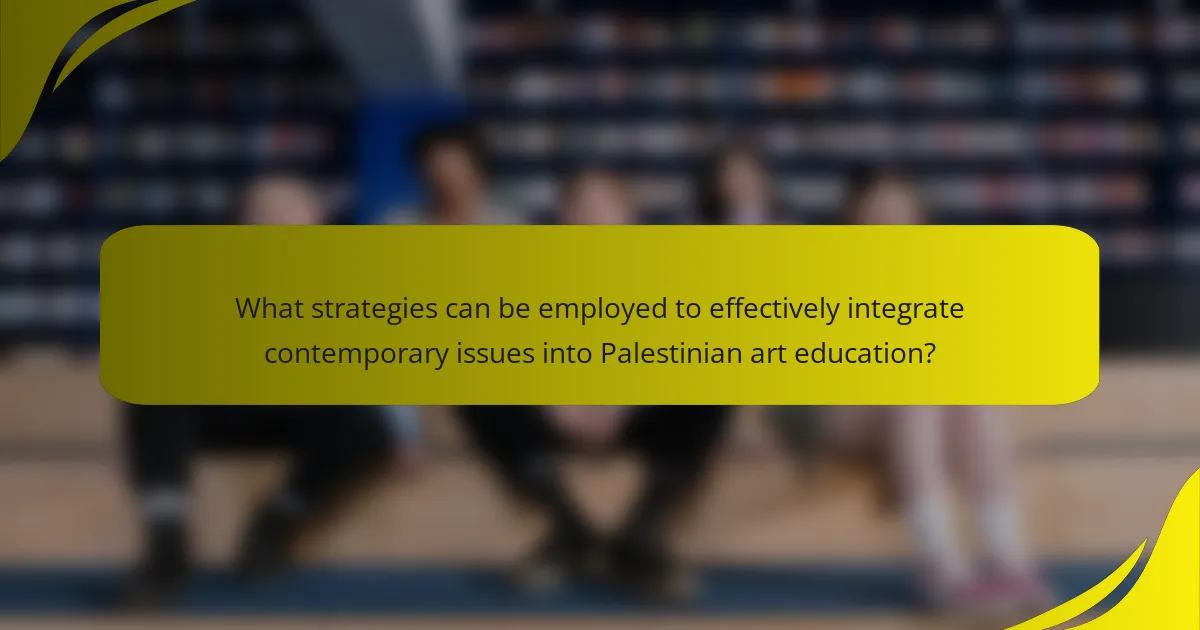
What strategies can be employed to effectively integrate contemporary issues into Palestinian art education?
Incorporating contemporary issues into Palestinian art education can be achieved through several strategies. First, educators can design curricula that reflect current social and political contexts. This approach allows students to engage with real-world challenges. Second, integrating community-based projects can foster a connection between students and their surroundings. These projects can address local issues and encourage students to express their perspectives through art. Third, collaboration with local artists can provide mentorship opportunities. This connection helps students learn from professionals who navigate contemporary themes in their work. Fourth, utilizing digital platforms can expand access to diverse viewpoints. Online resources can expose students to global contemporary art practices. Lastly, promoting critical discussions in the classroom can enhance students’ analytical skills. Engaging in debates about contemporary issues encourages deeper understanding and personal expression. These strategies collectively support the integration of contemporary issues into Palestinian art education.
How can educators develop relevant curricula that address contemporary issues?
Educators can develop relevant curricula by incorporating contemporary issues into their teaching materials. This involves identifying current social, political, and cultural topics that resonate with students. Engaging students in discussions about these issues fosters critical thinking. Additionally, integrating local context, such as Palestinian history and culture, enhances relevance. Collaborating with community members can provide authentic perspectives. Research shows that curricula addressing contemporary issues increase student engagement and understanding. For example, studies indicate that students are more motivated when learning about issues that affect their lives directly.
What collaborative approaches can be taken with local artists and communities?
Collaborative approaches with local artists and communities include workshops, public art projects, and community exhibitions. Workshops allow artists to share skills and techniques with community members. Public art projects can engage residents in creating murals or installations. Community exhibitions showcase local talent and foster dialogue about contemporary issues. Partnerships with schools can integrate art into education, promoting cultural awareness. Collaborative grants can fund projects that address social themes. These approaches enhance community engagement and promote cultural identity.
How can technology be utilized to enhance art education?
Technology can enhance art education by providing interactive tools and resources. Digital platforms allow students to access a wide range of artistic styles and techniques. Virtual reality can immerse students in famous artworks and historical contexts. Online courses expand learning opportunities beyond traditional classrooms. Art creation software enables students to experiment with digital art forms. Collaboration tools facilitate peer feedback and group projects. Social media allows for sharing artwork and receiving global perspectives. Research shows that technology increases student engagement and creativity in art education.
What role do workshops and community projects play in this integration?
Workshops and community projects are essential for integrating contemporary issues into Palestinian art education. They provide hands-on learning experiences that connect students to real-world challenges. These initiatives foster collaboration among artists, educators, and community members. Workshops often focus on relevant social, political, and cultural themes. This relevance enhances students’ understanding of their environment. Community projects allow for the exploration of local narratives through artistic expression. They also encourage critical thinking and dialogue about contemporary issues. Evidence shows that such programs increase engagement and creativity among participants.
How can hands-on experiences foster understanding of contemporary issues?
Hands-on experiences can foster understanding of contemporary issues by engaging individuals in active learning. This approach allows participants to directly interact with the subject matter. For example, art projects that address social justice can help students comprehend the complexities of these issues. Engaging in community-based initiatives can also provide real-world context. Research shows that experiential learning enhances critical thinking skills. According to a study published in the Journal of Experiential Education, students involved in hands-on activities demonstrate increased empathy and awareness. These experiences create a deeper connection to the material, promoting a more nuanced understanding of contemporary challenges.
What are some successful examples of community engagement in art education?
Successful examples of community engagement in art education include collaborative mural projects and community art festivals. These initiatives often involve local artists and residents working together to create public art. For instance, the “Art in the Streets” project in Los Angeles brought together diverse communities to express their cultural identities through murals. Similarly, the “Community Arts Program” in Chicago engages youth in art-making activities that address social issues. Research shows that such projects enhance community cohesion and foster dialogue. The National Endowment for the Arts reported that community art initiatives lead to increased civic engagement and social capital.
What practical tips can help educators integrate contemporary issues into their art teaching?
Educators can integrate contemporary issues into their art teaching by incorporating current events into lesson plans. They should encourage students to explore social justice themes through their artwork. Discussion of local and global issues can inspire artistic expression. Collaborative projects can foster critical thinking and community engagement. Utilizing multimedia resources can provide diverse perspectives on contemporary topics. Field trips to galleries or community events can enhance real-world connections. Inviting guest speakers from various backgrounds can enrich the learning experience. Regular reflection on students’ work can help them articulate their views on contemporary issues.
The main entity of this article is the integration of contemporary issues into Palestinian art education. The article outlines how incorporating current social, political, and cultural themes into art curricula fosters critical thinking, dialogue, and a unique Palestinian artistic voice among students. It discusses the influence of contemporary issues on art education, the challenges faced in this integration, and the benefits it provides, including enhanced cultural awareness and sensitivity. Additionally, it highlights practical strategies for educators to effectively incorporate these themes, emphasizing the importance of community engagement and hands-on experiences in fostering understanding of contemporary issues.
